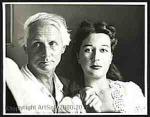Dorothea Tanning
Dorothea Tanning
Style: Surrealism;
Place: Galesburg
Born: 1910
Death: 2012
Biography:
Dorothea Margaret Tanning was an American painter, printmaker, sculptor, writer, and poet. Her early work was influenced by Surrealism.
Dorothea Tanning was born and raised in Galesburg, Illinois. In 1926 Tanning attended Galesburg public schools. When she was attending high school Tanning "skipped" two grades, which led to a lifelong weakness in arithmetic. After attending Knox College for two years (1928–30), she moved to Chicago in 1930 and then to New York in 1935. There she supported herself as a commercial artist while pursuing her own painting, and discovered Surrealism at the Museum of Modern Art’s seminal 1936 exhibition, Fantastic Art, Dada and Surrealism. After an eight-year relationship, she was married briefly to the writer Homer Shannon in 1941. Impressed by her creativity and talent in illustrating fashion advertisements, the art director at Macy’s department store introduced her to the gallery owner Julien Levy, who immediately offered to show her work. Levy later gave Tanning two one-person exhibitions (in 1944 and 1948), and also introduced her to the circle of émigré Surrealists whose work he was showing in his New York gallery, including the German painter Max Ernst.
Tanning first met Ernst at a party in 1942. Later he dropped by her studio to consider her work for an exhibition of work by women artists at The Art of This Century gallery, which was owned by Peggy Guggenheim, Ernst's wife at the time. As Tanning recounts in her memoirs, he was enchanted by her iconic self-portrait Birthday (1942, Philadelphia Museum of Art). The two played chess, fell in love, and embarked on a life together that took them to Sedona in Arizona, and later to France. They lived in New York for several years before moving to Sedona, where they built a house and hosted visits from many friends crossing the country, including Henri Cartier-Bresson, Lee Miller, Roland Penrose, Yves Tanguy, Kay Sage, Pavel Tchelitchew, George Balanchine, and Dylan Thomas. Tanning and Ernst were married in 1946 in a double wedding with Man Ray and Juliet Browner in Hollywood and they were married for 30 years.
In 1949, Tanning and Ernst relocated to France, where they divided their time between Paris and Touraine, returning to Sedona for intervals through the early and mid 1950s. They lived in Paris and later Provence until Ernst's death in 1976 (he had suffered a stroke a year earlier), after which Tanning returned to New York. She continued to create studio art in the 1980s, then turned her attention to her writing and poetry in the 1990s and 2000s, working and publishing until the end of her life. Tanning died on January 31, 2012, at her Manhattan home at age 101.
Apart from three weeks she spent at the Chicago Academy of Fine Art in 1930, Tanning was a self-taught artist. The surreal imagery of her paintings from the 1940s and her close friendships with artists and writers of the Surrealist Movement have led many to regard Tanning as a Surrealist painter, yet she developed her own individual style over the course of an artistic career that spanned six decades.
Tanning’s early works – paintings such as Birthday and Eine kleine Nachtmusik (1943, Tate Modern, London) – were precise figurative renderings of dream-like situations. Like other Surrealist painters, she was meticulous in her attention to details and in building up surfaces with carefully muted brushstrokes. In 1943, Tanning was included in Peggy Guggenheim's show Exhibition by 31 Women at the Art of This Century gallery in New York. Through the late 1940s, she continued to paint depictions of unreal scenes, some of which combined erotic subjects with enigmatic symbols and desolate space. During this period she formed enduring friendships with, among others, Marcel Duchamp, Joseph Cornell, and John Cage; designed sets and costumes for several of George Balanchine's ballets, including The Night Shadow (1945) at the Metropolitan Opera House; and appeared in two of Hans Richter's avant-garde films.
Over the next decade, Tanning's painting evolved, becoming less explicit and more suggestive. Now working in Paris and Huismes, France, she began to move away from Surrealism and develop her own style. During the mid-1950s, her work radically changed and her images became increasingly fragmented and prismatic, exemplified in works such as Insomnias (1957, Moderna Museet, Stockholm). As she explains, "Around 1955 my canvases literally splintered... I broke the mirror, you might say.”
By the late 1960s, Tanning’s paintings were almost completely abstract, yet always suggestive of the female form. From 1969 to 1973, Tanning concentrated on a body of three-dimensional work, soft, fabric sculptures, five of which comprise the installation Hôtel du Pavot, Chambre 202 (1970–73) that is now in the permanent collection of the Musée National d'Art Moderne at the Centre Georges Pompidou, Paris. During her time in France in the 1950s-70s, Tanning also became an active printmaker, working in ateliers of Georges Visat and Pierre Chave and collaborating on a number of limited edition artists’ books with such poets as Alain Bosquet, Rene Crevel, Lena Leclerq, and André Pieyre de Mandiargues. After her husband's death in 1976, Tanning remained in France for several years with a renewed concentration on her painting. These years included, for Dorothea Tanning, an intense five- year adventure in soft sculpture. By 1980 she had relocated her home and studio to New York and embarked on an energetic creative period in which she produced paintings, drawings, collages, and prints.
More...
Wikipedia link: Click Here














